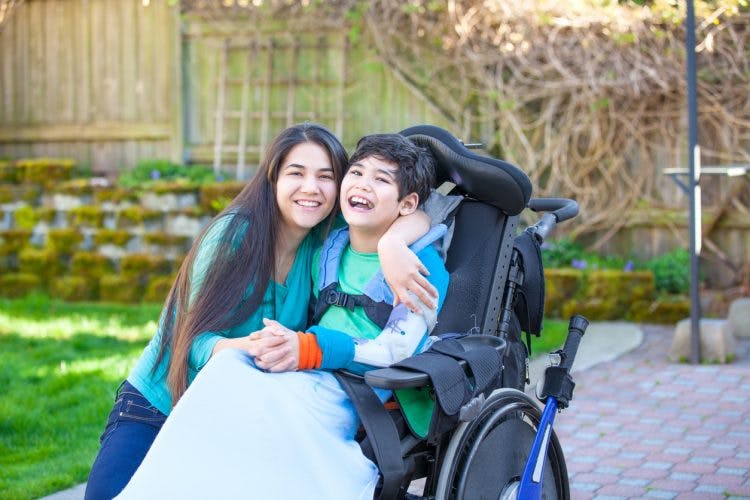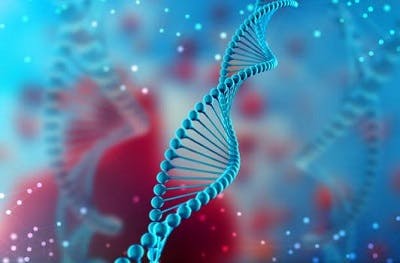No products in the cart.
No products in the cart.
No products in the cart.
No products in the cart.
Home » Neurological Recovery Blog » Cerebral Palsy » Cerebral Palsy and Muscular Dystrophy: How Are These Conditions Different?
Last updated on April 5, 2021

Both cerebral palsy and muscular dystrophy can involve abnormal muscle tone along with poor balance and posture. However, the two conditions are distinctly separate.
To help you understand the main differences between cerebral palsy and muscular dystrophy (particularly Duchenne muscular dystrophy, the most common type), this article is going to compare and contrast the two conditions side-by-side.
Both cerebral palsy and muscular dystrophy start in early childhood and affect the muscles. However, they have many distinctions.
Let’s compare and contrast key points between cerebral palsy and muscular dystrophy:

Cerebral palsy is caused by damage to the brain before or during birth, or in early childhood.
Common causes of cerebral palsy include:
Muscular dystrophy is caused by a genetic mutation in the DNA where the body cannot produce a protein called dystrophin. Dystrophin helps strengthen muscle fibers and keeps them intact during contractions.
Cerebral palsy is considered a neurological disorder while muscular dystrophy is considered a genetic disorder. While genetic factors can contribute to the occurrence of cerebral palsy, there is no single gene for cerebral palsy like there is for muscular dystrophy.

Both cerebral palsy and muscular dystrophy can be characterized by abnormal muscle tone, which affects balance, posture, and control over movements. The conditions often go unnoticed in infants until they start to demonstrate developmental delays. Most children are diagnosed between 18-24 months.
While cerebral palsy is mostly characterized by high muscle tone, there is also a type of cerebral palsy that is characterized by hypotonia (low muscle tone). Muscular dystrophy is characterized by the progressive weakening of the muscles. Those with muscular dystrophy demonstrate decreasing muscle tone as their condition progresses.
By the time children with muscular dystrophy reach their teenage years, they’ll likely experience respiratory and cardiac problems. This is because the heart and diaphragm are muscles, and the lack of dystrophin can cause them to dysfunction.
Some co-occurring health conditions that are commonly experienced by individuals with cerebral palsy and individuals with muscular dystrophy include:

Muscular dystrophy is an X-linked recessive disease, which makes it much more common in males than females.
Males have 1 X chromosome and 1 Y chromosome, while females have 2 X chromosomes. If one X chromosome is mutated in a female, the other one may still be functional and dominate over the mutation; however, if the single X chromosome in a male is mutated, they can have muscular dystrophy.
Duchenne muscular dystrophy affects approximately 1 in every 3,500 to 5,000 male births. It primarily affects boys but can also affect girls. “Approximately 8% of female Duchenne muscular dystrophy carriers are manifesting carriers and have muscle weakness to some extent,” according to this study.
Cerebral palsy is the most common childhood motor disability and it affects about 2-3 in every 1000 births. Like muscular dystrophy, CP is more common amongst males than females, but for unknown reasons and to a much lesser extent.

Cerebral palsy is static, meaning that the severity of the brain damage causing it will not get worse over time. Every case of cerebral palsy is unique, so depending on the severity of damage to the brain, management of symptoms, and overall health, life expectancy for individuals with CP can vary quite a bit.
In contrast, muscular dystrophy is a progressive disorder, and its severity only worsens with time. By the time individuals with muscular dystrophy become 15 years old, over 90% are using wheelchairs.
Historically, people with muscular dystrophy rarely lived past their teen years; however, thanks to innovations in healthcare, survival into the 30s, 40s, and even 50s is becoming increasingly more common.

Management for cerebral palsy or muscular dystrophy requires personalized plans that focus on each individual’s unique abilities, concerns, and needs.
Generally, management interventions will include:
As symptoms of muscular dystrophy start to worsen, doctors may prescribe corticosteroids like prednisone or deflazacort to help delay muscle degradation and prolong muscle functions.
Additionally, as breathing functions start to weaken, a ventilator may be necessary for breathing support. For the weakening of cardiac functions, medications like corticosteroids, ACE-inhibitors, and beta-blockers will be prescribed.

Let’s review some of the main similarities and differences between cerebral palsy and Duchenne muscular dystrophy.
Cerebral palsy and muscular dystrophy are both childhood neuromuscular disorders. Muscular dystrophy is genetic and caused by a deletion in the DNA sequence that codes for the production of dystrophin, a protein that protects muscles.
Unlike muscular dystrophy, there is no single gene for cerebral palsy; however, a combination of genetic factors may increase one’s likelihood of developing CP. Cerebral palsy is static (the brain damage will not worsen over time) and muscular dystrophy is progressive (muscle degradation worsens with increasing age).
Luckily, thanks to advances in healthcare and medicine, muscle functions in individuals with muscular dystrophy are being prolonged, which is leading to longer life expectancies. We hope this article helped you understand the primary distinctions between these two conditions.

Get our free 19-page PDF full of helpful tips for cerebral palsy by signing up below! If you liked this article, you’ll LOVE our free ebook.
When you sign up, you’ll also receive our popular emails that share more tips for life with cerebral palsy — you can opt out anytime.
We will never sell your email address, and we never spam. That we promise.


At Flint Rehab, we understand that doing physical therapy at home can become tedious and repetitive. But when repetition is critical to recovery, it’s important to stick with a repetitive regimen. But that doesn’t mean it has to be boring.
Flint Rehab is the leading manufacturer of motion-sensing, gamified rehabilitation devices. Our bestselling recovery tool, FitMi, transforms full-body rehab exercises into an interactive experience.
See what individuals with CP are saying about FitMi:
“The FitMi and MusicGlove have done wonders for my son with hemiparesis from cerebral palsy and stroke. It motivates him to do his exercises. It does not seem like therapy for him since it is fun. FitMi monitors his progress so it is a great reinforcement for him. Music is a motivator for him. He has been using it on his arm and we will try the leg exercises soon.”
-Manning
While FitMi is a recovery tool for the full-body, our other device, MusicGlove, helps target the hand to improve fine motor skills and dexterity.
See what others have said about MusicGlove:
“My granddaughter has right-side hemiplegia from Cerebral Palsy / stroke at birth. She states that this is a great product for anyone who has issues with the use of their hand(s), and that is has helped her tremendously. She also finds the music quite catchy (surprisingly!). Our occupational therapist has been impressed as well. I can say that it has arguably been the best tool of all our therapy resources.”
-Jenni
Together, FitMi and MusicGlove make a powerful home therapy regimen for individuals with cerebral palsy. Best of all, you can save money when you bundle them together.
To learn more, click the button below:

Do you have these 19 pages of helpful tips for CP?
Get a free copy of our ebook Helpful Tips for Managing Cerebral Palsy. Click here to get instant access.
Grab a free rehab exercise ebook!
Sign up to receive a free PDF ebook with recovery exercises for stroke, traumatic brain injury, or spinal cord injury below: